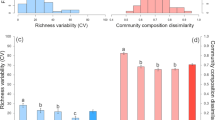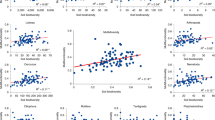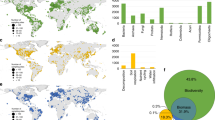Abstract
Soils support an immense portion of Earth’s biodiversity and maintain multiple ecosystem functions which are essential for human well-being. Environmental thresholds are known to govern global vegetation patterns, but it is still unknown whether they can be used to predict the distribution of soil organisms and functions across global biomes. Using a global field survey of 383 sites across contrasting climatic and vegetation conditions, here we showed that soil biodiversity and functions exhibited pervasive nonlinear patterns worldwide and are mainly governed by water availability (precipitation and potential evapotranspiration). Changes in water availability resulted in drastic shifts in soil biodiversity (bacteria, fungi, protists and invertebrates) and soil functions including plant–microbe interactions, plant productivity, soil biogeochemical cycles and soil carbon sequestration. Our findings highlight that crossing specific water availability thresholds can have critical consequences for the provision of essential ecosystem services needed to sustain our planet.



Similar content being viewed by others
Data availability
All the materials, raw data and protocols used in the article are available upon request and without restriction and all data that support the main findings of this study will be made publicly available in Figshare76 upon publication.
Code availability
The data in this study were analysed with publicly available tool packages in R and the figures were produced with R. The R code used in the analysis presented in this paper is available in Figshare76.
References
Amundson, R. et al. Soil and human security in the 21st century. Science 348, 1261071 (2015).
Bardgett, R. D. & van der Putten, W. H. Belowground biodiversity and ecosystem functioning. Nature 515, 505–511 (2014).
Delgado-Baquerizo, M. et al. Multiple elements of soil biodiversity drive ecosystem functions across biomes. Nat. Ecol. Evol. 4, 210–220 (2020).
Johnston, A. S. A. et al. Temperature thresholds of ecosystem respiration at a global scale. Nat. Ecol. Evol. 5, 487–494 (2021).
Berdugo, M. et al. Global ecosystem thresholds driven by aridity. Science 367, 787–790 (2020).
Wang, C. et al. The temperature sensitivity of soil: microbial biodiversity, growth, and carbon mineralization. ISME J. 15, 2738–2747 (2021).
Feng, Y. et al. Temperature thresholds drive the global distribution of soil fungal decomposers. Glob. Change Biol. 28, 2779–2789 (2022).
Jarzyna, M. A. & Jetz, W. Taxonomic and functional diversity change is scale dependent. Nat. Commun. 9, 2565 (2018).
Martiny, J. B., Eisen, J. A., Penn, K., Allison, S. D. & Horner-Devine, M. C. Drivers of bacterial β-diversity depend on spatial scale. Proc. Natl Acad. Sci. USA 108, 7850–7854 (2011).
Fierer, N. & Jackson, R. B. The diversity and biogeography of soil bacterial communities. Proc. Natl Acad. Sci. USA 103, 626–631 (2006).
Bastida, F. et al. Soil microbial diversity–biomass relationships are driven by soil carbon content across global biomes. ISME J. 15, 2081–2091 (2021).
Zwerschke, N., Bollen, M., Molis, M. & Scrosati, R. A. An environmental stress model correctly predicts unimodal trends in overall species richness and diversity along intertidal elevation gradients. Helgol. Mar. Res. 67, 663–674 (2013).
Scheffer, M. et al. Early-warning signals for critical transitions. Nature 461, 53–59 (2009).
Qi, Y., Xu, M. & Wu, J. Temperature sensitivity of soil respiration and its effects on ecosystem carbon budget: nonlinearity begets surprises. Ecol. Model. 153, 131–142 (2002).
Huang, J. P., Yu, H. P., Guan, X. D., Wang, G. Y. & Guo, R. X. Accelerated dryland expansion under climate change. Nat. Clim. Change 6, 166–171 (2016).
Berdugo, M., Vidiella, B., Sole, R. V. & Maestre, F. T. Ecological mechanisms underlying aridity thresholds in global drylands. Funct. Ecol. 36, 4–23 (2022).
van den Hoogen, J. et al. Soil nematode abundance and functional group composition at a global scale. Nature 572, 194–198 (2019).
Phillips, H. R. P. et al. Global data on earthworm abundance, biomass, diversity and corresponding environmental properties. Sci. Data 8, 136 (2021).
Maestre, F. T. et al. Plant species richness and ecosystem multifunctionality in global drylands. Science 335, 214–218 (2012).
Wieder, W. R., Cleveland, C. C., Smith, W. K. & Todd-Brown, K. Future productivity and carbon storage limited by terrestrial nutrient availability. Nat. Geosci. 8, 441–444 (2015).
Liang, C., Amelung, W., Lehmann, J. & Kastner, M. Quantitative assessment of microbial necromass contribution to soil organic matter. Glob. Change Biol. 25, 3578–3590 (2019).
Guerra, C. A. et al. Blind spots in global soil biodiversity and ecosystem function research. Nat. Commun. 11, 3870 (2020).
Hagedorn, F., Gavazov, K. & Alexander, J. M. Above- and belowground linkages shape responses of mountain vegetation to climate change. Science 365, 1119–1123 (2019).
Soliveres, S. et al. Biodiversity at multiple trophic levels is needed for ecosystem multifunctionality. Nature 536, 456–459 (2016).
Stevenson, A. et al. Is there a common water-activity limit for the three domains of life? ISME J. 9, 1333–1351 (2015).
Moyano, F. E., Manzoni, S. & Chenu, C. Responses of soil heterotrophic respiration to moisture availability: an exploration of processes and models. Soil Biol. Biochem. 59, 72–85 (2013).
Willig, M. R. Biodiversity and productivity. Science 333, 1709–1710 (2011).
Liu, Y. R. et al. Global diversity and ecological drivers of lichenised soil fungi. New Phytol. 231, 1210–1219 (2021).
Lu, M. & Hedin, L. O. Global plant–symbiont organization and emergence of biogeochemical cycles resolved by evolution-based trait modelling. Nat. Ecol. Evol. 3, 239–250 (2019).
Harris, J. Soil microbial communities and restoration ecology: facilitators or followers? Science 325, 573–574 (2009).
Montane, F., Romanya, J., Rovira, P. & Casals, P. Aboveground litter quality changes may drive soil organic carbon increase after shrub encroachment into mountain grasslands. Plant Soil 337, 151–165 (2010).
Keiluweit, M., Gee, K., Denney, A. & Fendorf, S. Anoxic microsites in upland soils dominantly controlled by clay content. Soil Biol. Biochem. 118, 42–50 (2018).
Konapala, G., Mishra, A. K., Wada, Y. & Mann, M. E. Climate change will affect global water availability through compounding changes in seasonal precipitation and evaporation. Nat. Commun. 11, 3044 (2020).
He, D. et al. Diversity and co-occurrence network of soil fungi are more responsive than those of bacteria to shifts in precipitation seasonality in a subtropical forest. Soil Biol. Biochem. 115, 499–510 (2017).
Liu, S. E. et al. Phylotype diversity within soil fungal functional groups drives ecosystem stability. Nat. Ecol. Evol. 6, 900–909 (2022).
van der Heijden, M. G. A. et al. Mycorrhizal fungal diversity determines plant biodiversity, ecosystem variability and productivity. Nature 396, 69–72 (1998).
Delgado-Baquerizo, M. et al. Decoupling of soil nutrient cycles as a function of aridity in global drylands. Nature 502, 672–676 (2013).
Maestre, F. T. et al. Grazing and ecosystem service delivery in global drylands. Science 378, 915–920 (2022).
Delgado-Baquerizo, M. et al. Changes in belowground biodiversity during ecosystem development. Proc. Natl Acad. Sci. USA 116, 6891–6896 (2019).
Zhang, K., Delgado-Baquerizo, M., Zhu, Y. G. & Chu, H. Space is more important than season when shaping soil microbial communities at a large spatial scale. mSystems 5, e00783–00719 (2020).
Kettler, T. A., Doran, J. W. & Gilbert, T. L. Simplified method for soil particle-size determination to accompany soil-quality analyses. Soil Sci. Soc. Am. J. 65, 849–852 (2001).
Fick, S. E. & Hijmans, R. J. WorldClim 2: new 1‐km spatial resolution climate surfaces for global land areas. Int. J. Climatol. 37, 4302–4315 (2017).
Zomer, R. J., Xu, J. & Trabucco, A. Version 3 of the global aridity index and potential evapotranspiration database. Sci. Data 9, 409 (2022).
Hijmans, R. J., Cameron, S. E., Parra, J. L., Jones, P. G. & Jarvis, A. Very high resolution interpolated climate surfaces for global land areas. Int. J. Climatol. 25, 1965–1978 (2005).
Fierer, N. et al. Cross-biome metagenomic analyses of soil microbial communities and their functional attributes. Proc. Natl Acad. Sci. USA 109, 21390–21395 (2012).
Ramirez, K. S. et al. Biogeographic patterns in below-ground diversity in New York City’s Central Park are similar to those observed globally. Proc. Biol. Sci. 281, 20141988 (2014).
Caporaso, J. G. et al. QIIME allows analysis of high-throughput community sequencing data. Nat. Methods 7, 335–336 (2010).
Edgar, R. C. Search and clustering orders of magnitude faster than BLAST. Bioinformatics 26, 2460–2461 (2010).
Edgar, R. C. UPARSE: highly accurate OTU sequences from microbial amplicon reads. Nat. Methods 10, 996–998 (2013).
Quast, C. et al. The SILVA ribosomal RNA gene database project: improved data processing and web-based tools. Nucleic Acids Res. 41, D590–D596 (2013).
Guillou, L. et al. The Protist Ribosomal Reference database (PR2): a catalog of unicellular eukaryote small sub-unit rRNA sequences with curated taxonomy. Nucleic Acids Res. 41, D597–D604 (2013).
Nguyen, N. H. et al. FUNGuild: an open annotation tool for parsing fungal community datasets by ecological guild. Fungal Ecol. 20, 241–248 (2016).
Yang, G., Wagg, C., Veresoglou, S. D., Hempel, S. & Rillig, M. C. How soil biota drive ecosystem stability. Trends Plant Sci. 23, 1057–1067 (2018).
Pettorelli, N. et al. Using the satellite-derived NDVI to assess ecological responses to environmental change. Trends Ecol. Evol. 20, 503–510 (2005).
Horne, D. J. & Scotter, D. R. The available water holding capacity of soils under pasture. Agric. Water Manag. 177, 165–171 (2016).
Sala, O. E., Parton, W. J., Joyce, L. A. & Lauenroth, W. K. Primary production of the central grassland region of the United States. Ecology 69, 40–45 (1988).
Grizzetti, B., Lanzanova, D., Liquete, C., Reynaud, A. & Cardoso, A. C. Assessing water ecosystem services for water resource management. Environ. Sci. Policy 61, 194–203 (2016).
Helalia, A. M. The relation between soil infiltration and effective porosity in different soils. Agric. Water Manag. 24, 39–47 (1993).
Lipiec, J., Kuś, J., Słowińska-Jurkiewicz, A. & Nosalewicz, A. Soil porosity and water infiltration as influenced by tillage methods. Soil Tillage Res. 89, 210–220 (2006).
Schmidt, M. W. et al. Persistence of soil organic matter as an ecosystem property. Nature 478, 49–56 (2011).
Jackson, R. B. et al. The ecology of soil carbon: pools, vulnerabilities, and biotic and abiotic controls. Annu. Rev. Ecol. Evol. Syst. 48, 419–445 (2017).
Sinsabaugh, R. L. et al. Stoichiometry of soil enzyme activity at global scale. Ecol. Lett. 11, 1252–1264 (2008).
Ekenler, M. & Tabatabai, M. A. β-Glucosaminidase activity as an index of nitrogen mineralization in soils. Commun. Soil. Sci. Plan. 35, 1081–1094 (2004).
Bell, C. W. et al. High-throughput fluorometric measurement of potential soil extracellular enzyme activities. J. Vis. Exp. 81, e50961 (2013).
Heimann, M. & Reichstein, M. Terrestrial ecosystem carbon dynamics and climate feedbacks. Nature 451, 289–292 (2008).
Campbell, C. D., Chapman, S. J., Cameron, C. M., Davidson, M. S. & Potts, J. M. A rapid microtiter plate method to measure carbon dioxide evolved from carbon substrate amendments so as to determine the physiological profiles of soil microbial communities by using whole soil. Appl. Environ. Microbiol. 69, 3593–3599 (2003).
Bloem, J., Hopkins, D. W. & Benedetti, A. Microbiological Methods for Assessing Soil Quality (CABI, 2005).
Fraser, F. C. et al. On the origin of carbon dioxide released from rewetted soils. Soil Biol. Biochem. 101, 1–5 (2016).
Dacal, M., Bradford, M. A., Plaza, C., Maestre, F. T. & Garcia-Palacios, P. Soil microbial respiration adapts to ambient temperature in global drylands. Nat. Ecol. Evol. 3, 232–238 (2019).
Yuan, J. et al. Predicting disease occurrence with high accuracy based on soil macroecological patterns of Fusarium wilt. ISME J. 14, 2936–2950 (2020).
Revelle, W. psych: Procedures for psychological, psychometric, and personality research. R package version 2.3.3 (2022).
Filzmoser, P., Maronna, R. & Werner, M. Outlier identification in high dimensions. Comput. Stat. Data 52, 1694–1711 (2008).
Fong, Y. et al. chngpt: Estimation and hypothesis testing for threshold regression. R package version 2022.4-6 (2021).
Hastie, T. gam: Generalized additive models. R package version 1.20 (2020).
Xun, W. B. et al. Specialized metabolic functions of keystone taxa sustain soil microbiome stability. Microbiome 9, 35 (2021).
Zhang, J. et al. Water availability creates global thresholds in multidimensional soil biodiversity and functions. Figshare https://doi.org/10.6084/m9.figshare.20004335 (2023).
Kottek, M., Grieser, J., Beck, C., Rudolf, B. & Rubel, F. World map of the Koppen–Geiger climate classification updated. Meteorol. Z. 15, 259–263 (2006).
Acknowledgements
Y.F. is supported by National Natural Science Foundation of China (42177297) and CAS Strategic Priority Research Program (XDA28010302). M.D.-B. acknowledges support from the Spanish Ministry of Science and Innovation for the I+D+i project PID2020-115813RA-I00 funded by MCIN/AEI/10.13039/501100011033. M.D.-B. is also supported by a project of the Fondo Europeo de Desarrollo Regional (FEDER) and the Consejería de Transformación Económica, Industria, Conocimiento y Universidades of the Junta de Andalucía (FEDER Andalucía 2014-2020 Objetivo temático ‘01—Refuerzo de la investigación, el desarrollo tecnológico y la innovación’) associated with the research project P20_00879 (ANDABIOMA). F.T.M. is supported by Generalitat Valenciana grant CIDEGENT/2018/041 and the Horizon Europe programme of the European Union (SOILGUARD, grant agreement no. 101000371). M.B. acknowledges funding from Spanish Ministry of Science and Innovation through a Ramón y Cajal Fellowship (no. RYC2021-031797-I). C.C. is supported by the European Commission under the Marie Sklodowska-Curie grant agreement no. 702057 (DRYLIFE). The survey of dryland areas was supported by the European Research Council (BIODESERT project, grant agreement no. 647038).
Author information
Authors and Affiliations
Contributions
M.D.-B., M.B. and Y.F. developed the original ideas. F.T.M., M.D.-B. and B.K.S. provided the original data. M.D.-B., F.T.M., B.K.S., T.S.-S., L.G.-V. and J.W. contributed to laboratory analyses. J.Z., Y.F., M.B., M.D.-B. and C.C. conducted statistical analyses. J.Z., Y.F. and M.D.-B. wrote the first draft of the manuscript and all authors contributed substantially to revisions.
Corresponding authors
Ethics declarations
Competing interests
The authors declare no competing interests.
Peer review
Peer review information
Nature Ecology & Evolution thanks Carly Stevens and the other, anonymous, reviewer(s) for their contribution to the peer review of this work.
Additional information
Publisher’s note Springer Nature remains neutral with regard to jurisdictional claims in published maps and institutional affiliations.
Extended data
Extended Data Fig. 1 Response patterns of the diversity of soil taxa to environmental variables.
Regression models represent the linear regressions before and after the average threshold if a statistical threshold exists, or linear regression if otherwise. The vertical lines and numbers in the plot denoted the detected thresholds. MAT mean annual temperature; PSEA and TSEA, seasonality of precipitation and temperature. Latitude uses its absolute values to denote the distance from the equator.
Extended Data Fig. 2 Differential slope at both sides of the environmental threshold.
Violin diagrams showing the bootstrapped (200 times) slope values of the regressions existing each side of environmental threshold. The data was standardized so that slope values are scaled to the same extent when displayed as above. Asterisks indicate a significant difference in regression slopes when conducting an unpaired two-sided Mann–Whitney U test between before and after the threshold where: * = P value < 0.05; ** = P value < 0.01; *** = P value < 0.001; **** = P value < 0.0001, ns = not significant.
Extended Data Fig. 3 The importance of environmental variables that are associated with nonlinear shifts in soil biodiversity.
Average variation degree (AVD) estimates the variation of the detected threshold values in each environmental among multiple soil organisms. A lower AVD suggests a more conservative environmental factor, and thus are assumed to be more important, in determining the nonlinear behaviour of soil biodiversity.
Extended Data Fig. 4 Importance of environmental factors in driving the distribution of soil biodiversity.
We used a random forest algorithm to estimate the importance of environmental factors and presented their importance value as an increase in mean squared error (IncMSE, %). The numbers in the boxes represent the variation explained by the model, and asterisk above bars denotes a significant influential factor at the significance level of P value < 0.05.
Extended Data Fig. 5 Nonlinear relationships between water availability and climatic seasonality.
The rest of the legend is the same as in Fig. 2 in the main text.
Extended Data Fig. 6 Response patterns of soil functions to environmental variables.
Regression models represent the linear regressions before and after the average threshold if a statistical threshold exists, or linear regression if otherwise. The vertical lines and numbers in the plot denoted the detected thresholds. Soil WHC, soil water-holding capacity; Soil AP, soil available phosphorus. Some variables, such as soil ammonium, nitrate and AP, chitin degradation, soil C, soil saprobes, mutualism, and pathogen control, are log-transformed to increase data normality.
Extended Data Fig. 7 Differences in the slope at both sides of the threshold identified.
Violin diagrams showing bootstrapped values of the slope of the two regressions at each side of every environmental threshold found in the study. Rest of legend is the same as in Extended Data Fig. 2.
Extended Data Fig. 8 Importance of environmental factors in driving the distribution of soil functions.
The legend is the same as Extended Data Fig. 4.
Supplementary information
Supplementary Information
Supplementary Figs 1–5 and Tables 1–3.
Rights and permissions
Springer Nature or its licensor (e.g. a society or other partner) holds exclusive rights to this article under a publishing agreement with the author(s) or other rightsholder(s); author self-archiving of the accepted manuscript version of this article is solely governed by the terms of such publishing agreement and applicable law.
About this article
Cite this article
Zhang, J., Feng, Y., Maestre, F.T. et al. Water availability creates global thresholds in multidimensional soil biodiversity and functions. Nat Ecol Evol 7, 1002–1011 (2023). https://doi.org/10.1038/s41559-023-02071-3
Received:
Accepted:
Published:
Issue Date:
DOI: https://doi.org/10.1038/s41559-023-02071-3
- Springer Nature Limited
This article is cited by
-
Climate-driven ecological thresholds in China’s drylands modulated by grazing
Nature Sustainability (2023)





